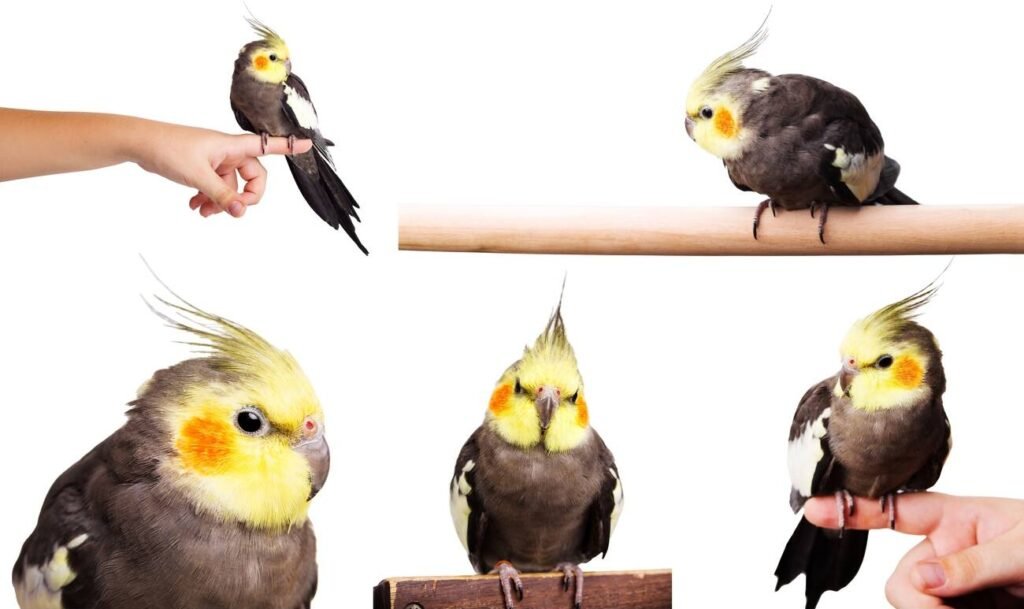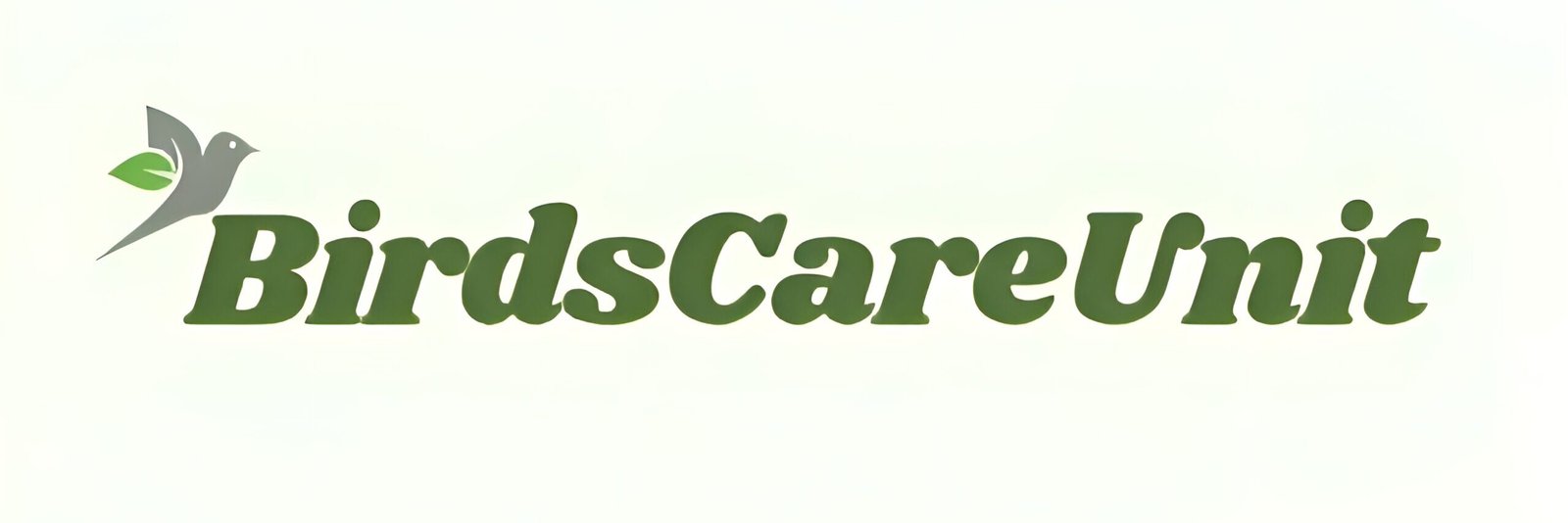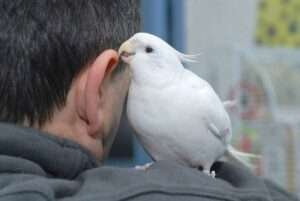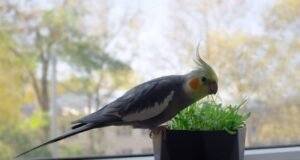Cockatiel Body Language: The Complete Guide to Understanding Your Cockatiel

I have a small pet bird colony at my home, which includes cockatiels, lovebirds, parakeets, and Barbary doves. As a pet bird owner, it’s essential to understand the habits, health, emotions, and behaviors of each species. Without this knowledge, it becomes difficult to properly care for them, and misunderstandings may arise, especially with birds like cockatiels. To become a successful pet bird expert, you need to be well-versed in every aspect of their nature.
Today, I’m focusing on cockatiel body language and what their various behaviors mean. Understanding this will make you a more effective cockatiel owner, especially if you’re a beginner breeder.
In this comprehensive guide, we’ll explore the many ways cockatiels communicate, the subtle signals they use, and how you can respond appropriately to ensure your bird remains happy, healthy, and secure. Whether you’re new to bird ownership or an experienced enthusiast, this detailed guide will offer valuable insights to help you decode the fascinating world of cockatiel communication.
1. Head Bobbing: What Does It Mean?
Head bobbing is one of the most common behaviors you’ll observe in cockatiels. However, this seemingly simple gesture can mean different things depending on the context and how frequently it happens.
Happy or Excited Bobbing
If your cockatiel bobs its head slowly and rhythmically, it’s usually a sign that they’re content. You might see this when you’re talking to them, feeding them a favorite treat, or during playful interactions. It’s their way of engaging with you and showing interest.
Erratic or Quick Bobbing
On the other hand, rapid or exaggerated head bobbing may indicate discomfort, anxiety, or overstimulation. If your bird is doing this while displaying other stressed behaviors like hissing or biting, it’s time to give them some space or assess the situation for potential stressors.
Illness Warning
If your bird’s head bobbing is accompanied by lethargy or a lack of appetite, it could be a sign of illness, particularly digestive issues. Monitoring other behaviors and consulting a vet is recommended.
2. Puffed-Up Feathers: Comfort or Concern?
Seeing your cockatiel fluff up its feathers can be both endearing and confusing. It’s important to recognize the various reasons behind this behavior to better assess your bird’s health and mood.
Relaxation and Comfort
A slight puffing up of feathers is common when your cockatiel is feeling comfortable or resting. You might notice this after they’ve eaten, while they’re preening, or before bedtime. It’s a sign they feel safe and content.
Feeling Cold
Birds often puff up to trap warm air close to their bodies when they feel chilly. If your bird is puffed up and it’s cool in the room, they might need some extra warmth. Ensure the cage is placed in a draft-free area and adjust the temperature as needed.
Signs of Illness
If your cockatiel is continuously puffed up, appears lethargic, or refuses to eat, it’s time to consult an avian vet. Prolonged puffing can indicate that they’re unwell or trying to conserve body heat because of an illness.
3. Cockatiel Hissing: Warning Signs to Watch For
Cockatiels may be cute, but they aren’t afraid to show when they’re upset. Hissing is one of their most direct vocal warnings.
Perceived Threats
Cockatiels hiss when they feel threatened or cornered. It’s often accompanied by a flattening of their crest feathers, making them look sleek and defensive. If you hear your bird hissing, stop what you’re doing and give them some space.
Protecting Territory
If your bird hisses when you’re approaching its cage, they may be feeling territorial. This can be common if they’ve recently been moved to a new location or are still adjusting to their environment.
Avoiding Aggression
Respecting your bird’s boundaries and providing a retreat space when they hiss can prevent further escalation, such as biting or lunging.
4. Biting Behavior: Why It Happens and How to Manage It
Biting is a behavior that many bird owners struggle with, but understanding the reasons behind it can help you manage it effectively.
Fear
Cockatiels bite when they’re scared. If your bird has been startled or feels threatened, a bite may follow. Avoid sudden movements or loud noises around your bird to prevent this.
Territoriality
Birds can become territorial over their cage, food, or toys. If they bite when you try to remove something from their cage, it’s a clear sign of territorial behavior.
Discomfort or Pain
If your bird suddenly starts biting when handled, it might be in pain. Check for injuries, overgrown nails, or other signs of physical discomfort.
Managing Biting
Never punish a bird for biting; this only increases fear and aggression. Instead, use positive reinforcement to encourage good behavior and reduce the likelihood of biting.
5. Signs of Aggression: Understanding and Preventing Conflicts
Aggression in cockatiels can often be anticipated by observing their body language. Early indicators can help you avoid escalation.
Raised Crest Feathers
A high, stiff crest signals that your bird is on high alert. They may be curious, excited, or about to become aggressive depending on the situation.
Rigid Body Posture
A cockatiel that stands tall with feathers slightly fluffed and tail feathers spread is often preparing to defend itself.
Sharp Vocalizations
If your cockatiel makes loud or sharp noises while displaying aggressive body language, it’s a clear warning sign.
6. Vocalizations: Listening to Your Cockatiel’s Noise
Cockatiels are vocal birds that use a range of sounds to communicate with their owners. Understanding these vocalizations is key to understanding their needs.
Chirping and Singing
These happy sounds indicate that your cockatiel is content. They may also sing to mimic noises they enjoy or to gain your attention.
Screaming
This loud, piercing sound can be a sign of distress, fear, or loneliness. Pay attention to when and why your bird is screaming to address its underlying needs.
Whistling
Cockatiels often whistle to communicate with their owners or other birds. It’s a friendly, non-aggressive sound that shows engagement and happiness.
7. Tail Wagging: Excitement or Anxiety
Tail wagging is another significant part of cockatiel body language, with the speed and context of the movement offering insights into your bird’s emotions.
Positive Tail Wagging
Excitement: If your bird is wagging its tail quickly, especially when combined with chirping, it’s likely feeling happy and energetic. This is common during playtime or when they’re about to receive a treat.
Negative Tail Wagging
Anxiety or Discomfort: If the tail wagging is slower or the bird’s body language suggests unease (e.g., tense posture or wide eyes), it could indicate anxiety or nervousness.
Takeaway: Understanding the context of tail wagging helps distinguish between excitement and unease.
8. Wing Flapping: Exercise or Frustration?
Cockatiels enjoy stretching their wings, and wing flapping is a natural part of their physical activity. It can be a sign of exercise or playfulness, but it can also signal frustration or anxiety depending on the context.
Positive Wing Flapping
Exercise: Cockatiels need to move their wings regularly to keep them strong and healthy. Flapping can be part of their natural exercise routine, especially if they don’t have a lot of free-flying time. You’ll often see this when they’re perching, as they flap their wings without taking off.
Excitement or Playfulness: Some birds flap their wings to express excitement, particularly during play or interaction with their favorite humans or toys.
Negative Wing Flapping
Frustration: If wing flapping occurs frequently and is accompanied by other signs of stress (like screaming or pacing), your cockatiel might be feeling frustrated. This can happen if they are bored, under-stimulated, or stuck in a small cage for too long.
Attention-Seeking Behavior: Some cockatiels flap their wings to get attention from their owners, especially if they’ve learned that this behavior elicits a reaction. If this becomes a pattern, it might indicate that your bird needs more interaction or mental stimulation.
Takeaway: Occasional wing flapping is normal and healthy, but persistent or frantic flapping may suggest frustration or a need for more attention and activity.
9. Crest Feathers: Understanding Cockatiel Emotions Through Crest Positioning
A cockatiel’s crest feathers are one of the most telling features when it comes to interpreting their emotions. By observing the position of their crest, you can get a good idea of how they’re feeling in any given moment.
Crest Raised and Upright
Curiosity or Excitement: A fully raised crest often indicates that your cockatiel is alert, curious, or excited. This is common when they encounter something new, like a toy, a new person, or even just hearing a sudden noise.
Mild Agitation: A slightly raised crest may also indicate that your bird is a little agitated or wary of their surroundings. If other body language suggests they’re uneasy, give them some space.
Crest Flattened Against the Head
Fear or Aggression: A flattened crest is a clear sign that your cockatiel is frightened or feeling aggressive. This can be accompanied by other warning signs such as hissing, lunging, or snapping. It’s essential to give your bird space if they exhibit this behavior.
Takeaway: The crest feathers are like a mood barometer for cockatiels. A raised crest often signals excitement, while a flattened crest indicates fear or aggression.
10. Lunging: Defensive Behavior or Fear
Lunging is when a cockatiel quickly thrusts its head forward in an attempt to snap or bite. This is generally a sign of defensiveness or fear, and understanding the cause can help you address the behavior before it escalates.
When Lunging Occurs
Territoriality: Cockatiels can become territorial, especially around their cages, toys, or food. Lunging may occur when they feel their space is being invaded.
Fear-Based Response: Lunging can also be a fear-driven reaction. If your bird feels cornered or threatened, lunging might be their way of protecting themselves.
How to Handle Lunging
Avoid Sudden Movements: Cockatiels don’t like to feel surprised. Approach your bird slowly and avoid sudden, jerky motions that could trigger a defensive lunge.
Build Trust Gradually: If your cockatiel is prone to lunging, it’s crucial to work on building trust. Hand-feed treats, talk softly, and spend quality time near their cage without forcing interaction.
Takeaway: Lunging is a clear defensive behavior, often linked to territoriality or fear. Patience and trust-building are key to reducing this behavior over time.
11. Head Snaking: Playfulness and Curiosity
One of the more quirky behaviors you’ll notice in cockatiels is head snaking, where they move their head from side to side in a fluid, almost hypnotic motion. This behavior is usually harmless and often points to playfulness or curiosity.
When You’ll See Head Snaking
During Playtime: Cockatiels sometimes snake their heads when they’re feeling playful or when they’re interacting with toys or mirrors. It’s often a sign of curiosity and engagement with their environment.
In Social Interactions: Head snaking may also occur when your bird is interacting with you or other birds, showing they’re engaged and interested in the interaction.
Takeaway: Head snaking is a playful and curious behavior that reflects your cockatiel’s mental engagement with its surroundings. Encouraging this through interaction and toys will keep them mentally stimulated.
12. Feather Plucking: Stress or Health Concerns
Feather plucking is one of the more concerning behaviors in cockatiels because it often indicates deeper issues, whether they are emotional or physical. It’s crucial to recognize and address feather plucking early on to prevent it from becoming a chronic habit.
Common Causes of Feather Plucking
Stress or Anxiety: A common cause of feather plucking is stress. This can be triggered by a change in environment, a lack of stimulation, loneliness, or even loud noises.
Boredom: Cockatiels are highly intelligent birds, and without enough mental stimulation, they can develop destructive habits like feather plucking.
Medical Issues: Feather plucking can also be a symptom of underlying health issues such as skin infections, parasites, or allergies. It’s essential to consult an avian veterinarian if your bird begins plucking its feathers.
How to Address Feather Plucking
Environmental Enrichment: Provide toys, perches, and out-of-cage time to keep your cockatiel engaged and stimulated.
Routine Check-Ups: Regular vet visits can help identify any medical issues that might be contributing to feather plucking.
Calm and Consistent Environment: Cockatiels are sensitive to changes, so maintaining a stable, calm environment can help reduce stress-related feather plucking.
Takeaway: Feather plucking is often a sign of stress or health problems. Providing a stimulating environment and addressing any medical concerns promptly can help mitigate this behavior.
13. Perching Habits: Monitoring Health Through Posture
A cockatiel’s perching habits can offer significant clues about its health and well-being. By observing how your bird perches, you can detect early signs of illness or discomfort.
Healthy Perching
Balanced and Stable: A healthy cockatiel will perch with a firm grip and balanced posture. They should be able to hop between perches and maintain a strong grip.
Perching on One Foot: It’s normal for cockatiels to stand on one foot, especially when they’re relaxed or sleeping. This indicates comfort and security.
Signs of Health Issues
Frequent Sitting or Lethargy: If your bird spends more time sitting rather than being active or exploring, it might be feeling unwell.
Unsteady Posture: An unsteady perch or trouble gripping could indicate weakness, injury, or a health issue that requires attention.
Takeaway: Observing perching habits provides valuable insight into your bird’s health. If you notice changes in how they perch, consult a veterinarian for further evaluation.
14. Recognizing Sickness: Early Detection Through Behavior
Cockatiels, like all birds, are good at hiding illness, a trait inherited from their wild ancestors to avoid appearing weak to predators. This makes it crucial for bird owners to recognize early signs of sickness through changes in behavior and body language.
Common Signs of Sickness
Lethargy: A once-active bird that suddenly becomes lethargic may be sick. Healthy cockatiels are energetic and curious.
Loss of Appetite: If your bird stops eating or drinks excessively, it could be a sign of illness.
Changes in Droppings: Abnormal droppings—either in color, consistency, or frequency—can signal digestive issues or other health concerns.
Labored Breathing: Respiratory issues are common in cockatiels. If you notice tail bobbing (the tail moves with each breath), wheezing, or open-mouth breathing, seek immediate veterinary care.
Fluffed Feathers for Extended Periods: Prolonged fluffing of feathers, especially if accompanied by lethargy or a lack of appetite, often indicates illness.
Takeaway: Early detection of illness through changes in behavior and body language is crucial for prompt treatment and recovery. Regular vet check-ups are key to maintaining your cockatiel’s health.
Conclusion: Fostering a Strong Bond Through Understanding
Cockatiels communicate through a rich array of body language and vocalizations. By learning to interpret their signals—whether it’s a raised crest, a gentle head bob, or a playful chirp—you can foster a stronger, more trusting relationship with your bird.
Understanding cockatiel body language not only helps you recognize when your bird is happy or stressed but also allows you to identify potential health issues and address them before they escalate. The key to maintaining a healthy and happy cockatiel is observation, patience, and understanding.



